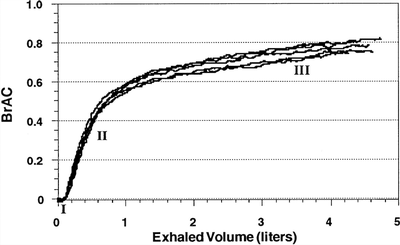The Fundamental Unfairness in Breath Alcohol Testing

In breath alcohol testing, the higher the percentage of your lung capacity you blow into the machine, the higher result you get. Since the machine has the same minimum volume of 1.5 liters for everyone, this means that people with smaller lung capacity have to blow a higher fraction of their lung capacity into the machine.
As you blow into the machine, your alcohol concentration continues to rise in proportion to the total volume of your lungs. The image below shows how your alcohol concentration rises as you continue to blow.
This is fundamentally unfair and, more importantly, at odds with the equal protection clause of the United States Constitution. In the U.S. we believe that all people should be treated fairly before the law.
The Fourteenth Amendment of the U.S. Constitution states that all persons in the United States are entitled to "equal protection of the laws," meaning they cannot be discriminated against without good reason. We don't want our government to treat people differently based on irrelevant factors such as lung size. That's called discrimination.
But that is exactly what the breath alcohol machine (breathalyzer) does! It doesn't take individual differences into account. Regardless of your lung size, the machine requires you to blow at least 1.5 liters.
For a young man whose height is 6' 2", this should be fairly easy. It would only require a small fraction of his lung capacity. But for a 5' 2" female of 65 years of age, this would require a significant fraction of her total lung capacity.

Image credit: The alcohol breath test—a review. Michael P. Hlastala
The State should use a fair test
Everyone has different lung capacities. Men have larger lungs than women, blacks have smaller lungs than whites, and older people have less lung capacity than younger people.
These aren’t numbers that I’ve made up. They come from the State’s own DMT Operator Training Manual.
For example, the State openly admits on page 134 of its training manual that blacks have smaller lungs. It says:
“The average predicted FVC (forced vital capacity) values for African Americans must be multiplied by 0.85 to account for ethnic differences.”
So does the state adjust the minimum requirements for blacks based on this? No, it doesn’t. But they should!
The breath machine doesn’t take individual lung size into account
We know that different people have different lung capacities depending on race, sex, age, and height. Some jurisdictions have even taken this fact into account.
In Germany, for example, the minimum sample size is based on your sex and age. They've at least attempted to take individual differences into account.
Check out how Germany programs their breath machines according to the chart below:

In MN, however, the State breath machine has the same minimum volume for everyone, regardless of lung capacity.
Don’t believe it? Take a look at page 21 of the State’s DMT Operator Training Manual. The minimum volume is 1.5 liters for everyone:

So, what? What's the big deal?
The problem with using the same minimum volume for everyone, regardless of their lung capacity, is that it discriminates against those with smaller lungs.
Women, certain ethnicities, and the elderly all must provide a higher percentage of their lung volume into the machine, and therefore get a higher score as a result. Those with large lung capacity can give what feels like a small puff into the machine and get a lower score because of it. But a person with small lungs would need to practically empty their lungs into the machine, and get a higher result because of it.
In America, we believe in fairness before the law. This belief is enshrined in our constitution in both the 5th and 14th Amendments. When our government violates our rights with unfair practices, it's our duty to fight back.
Contact Ramsay Law
At Ramsay Law, we understand science and the law. If you've been a victim of an unfair breath test, call us to get an advocate on your side.
Stay up to day with our latest updates, and subscribe to this blog by email.

